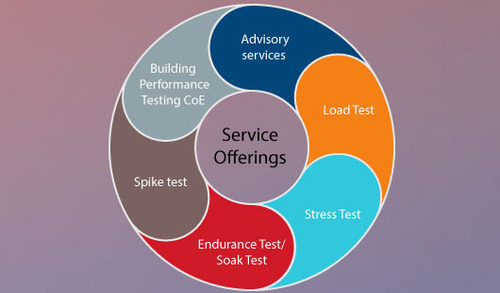Performance testing service is a non-functional software testing technique that determines how an application stability, speed, scalability, and responsiveness respond under a given workload. This is a major step towards ensuring software quality but, unfortunately, it is often seen as an analysis done in isolation, starting once the functional testing is complete, and in most cases, after the code is ready to be shared.
Performance testing objectives include evaluation of application output, processing speed, data transfer rate, network bandwidth usage, maximum parallel users, memory utilization, workload efficiency, and command response times.

Reasons for performance testing
Organizations test performance for at least one of the following reasons:
- To determine if the application meets operational requirements (for example, the system should handle 1,000 parallel users).
- To detect computer interruptions within the application.
- To establish whether the performance levels claimed by the software supplier are actually true.
- Compare two or more systems and identify the ones that work best.
- To measure stability in cases of traffic spikes.
How to perform performance tests?
Specific performance testing measures will vary from organization to organization. It depends on the performance indicators that the company considers most important. However, the overall goals of performance testing are largely the same, so there is a definite workflow that most testing plans will follow.
- Identify the production environment, testing environment and testing equipment at your disposal. Document hardware, software, infrastructure specifications and configuration in both testing and production environments to ensure compatibility. Some performance testing may take place in the production environment, but strict safety measures must be taken to prevent testing from affecting production performance.
- Define acceptable performance criteria. Here you must set limits and objectives that will demonstrate test success. The main criteria will be taken directly from the project specifications, but the testers must be properly empowered to establish a comprehensive set of tests and benchmarks.
- Planning and design testing. Think about the different uses and then create test scenarios that cover all possible use cases. Design tests accordingly and define the metrics that should be captured.
- Prepare your testing environment and equipment. Configure the test environment before running performance tests. Collect your available testing equipment.
- Run performance tests. Capture and monitor results.
- Solve and re-test. Strengthen and analyze test results. Share the findings with the project team. Adjust the application by eliminating identified performance flaws. Repeat the test to confirm that each problem has been permanently removed.
Tips for performance testing
Create a testing environment that reflects the product ecosystem as faithfully as possible. Without it, test results may not be an accurate representation of application performance when they are taken into action.
- Separate the environment from the UAT environment.
- Identify the testing tools that best automate your performance testing plan.
- Run tests several times to get an accurate measure of application performance. If you are doing a load test, for example, do the same test several times to determine if the result is consistent before marking the display as acceptable or unacceptable.
- Do not change the test environment between tests.
What are performance testing tools and how can professional testing companies help?
Because performance testing (view) attempts to establish the effectiveness of the system when subjected to various workloads, it is difficult to run such tests efficiently without the use of automated testing equipment. Testing equipment varies in their capacity, scope, sofistication and automation. A professional testing services company can help take the effectiveness of your performance testing to the next level. This can be done by configuring high-performance applications that exceed customer expectations with an integrated set of enterprise performance engineering solutions, ranging from developers to performance engineers.
Popular performance testing tools
- It is open source and probably the most used. It can measure the performance of a variety of services, but it’s focused on web applications.
- This tool was developed by Micro Focus and released in 1993. It is very useful for concurrency testing. In Windows and Linux, available in 11 languages, and from version 12.55 onwards you can run JMeter scripts.
- Developed in Java, and available for Windows, Linux, MacOS and Solaris. Its scripts are developed through an interface in a more intuitively way than the previous tools. It is also faster in test execution.

